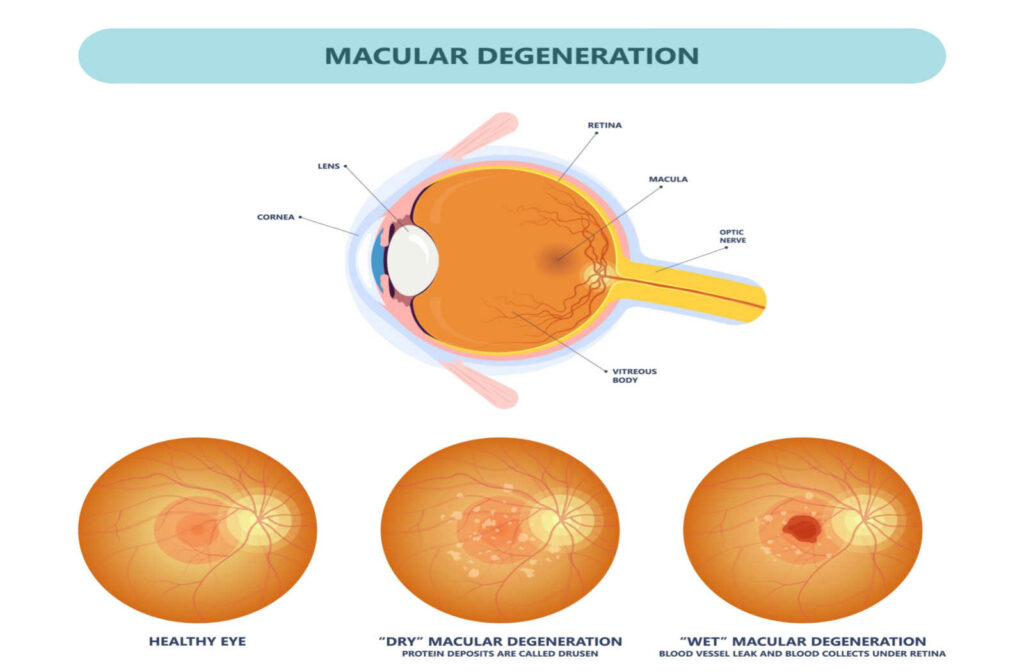Macular degeneration is an age-related eye condition that can cause reduced vision, most commonly in people over 40. It occurs when the central part of the retina, called the macula (responsible for sharp central vision), deteriorates over time.
Because the changes in macular degeneration are subtle, people don’t always have or notice symptoms. Early warning signs may include blurry vision, difficulty seeing in low light, and faded colors.
As the saying goes, prevention is better than cure, making regular comprehensive eye exams essential for the early detection of macular degeneration and preventing vision loss.
What Is Age-Related Macular Degeneration?
Age-related macular degeneration (AMD) is an eye disease that affects the macula, a small part of the retina at the back of the eye responsible for sharp, detailed central vision. Macular degeneration causes the macula to deteriorate over time.
The exact cause of AMD is not known. However, it does develop as the eyes age, the tissue in the macula thins, and it loses cells responsible for vision. Causes can also include a combination of factors, such as family genes, smoking, obesity, and diet.
AMD can lead to a progressive loss of central vision but doesn’t affect your peripheral or side vision. Losing central vision in AMD can make it difficult to read, recognize faces, drive, or perform everyday tasks that require detailed vision.
There are 2 types of macular degeneration:
- Dry macular degeneration is more common, affecting 85–90% of people with dry macular degeneration. In this type, the macular thins with age and can occur in one or both eyes.
- Wet macular degeneration is less common and occurs when new blood vessels grow under the retina (the light-sensitive tissue at the back of the eye), leaking blood and fluid.

Early Warning Signs of Macular Degeneration
The symptoms of AMD depend on the stage of the disease. Dry AMD occurs in 3 stages—early, intermediate, and late. Some of the early warning signs of macular degeneration include:
- Blurred vision: One of the earliest signs of macular degeneration is a gradual decrease in clarity. You may have difficulty seeing near or far and reading or recognizing faces.
- Reduced central vision: You may notice a dark or empty area in the center of your vision or see blank spots.
- Difficulty seeing in low light: You may notice that your eyes take longer to adjust to changes in lighting or that you need brighter lights to see clearly.
- Colors appear less vibrant: You may notice a decrease in color perception. Colors may appear less bright.
- Straight lines appear distorted: Macular degeneration can cause straight lines to appear wavy or crooked.
Treatment of Macular Degeneration
There is currently no cure for macular degeneration. However, there are ways to help slow its progression and manage symptoms to prevent or delay vision loss. There are a variety of management and treatment options based on the stage of macular degeneration.
Early Macular Degeneration
During the early stage of AMD, your eye doctor will monitor your eyes with regular exams and may recommend the following lifestyle changes:
- Quit smoking
- Eat a healthy diet
- Exercising regularly
- Maintain healthy blood pressure and cholesterol levels
- Reduce eye exposure to ultraviolet light
Intermediate Macular Degeneration
In the intermediate stage, your eye doctor may recommend supplements that help prevent further progression to late macular degeneration.
Late Wet Macular Degeneration
If you have late wet AMD, treatments to stop further vision loss can include:
- Anti-vascular endothelial growth factor (VEGF) injections can help stop the proliferation of abnormal vessels.
- Laser photocoagulation to seal leaking blood vessels.
Preventing Macular Degeneration
While AMD can lead to vision loss in older adults and the damage done by this condition is irreversible, knowing your risk and taking measures to prevent further damage can help lower your risk as you age.
The risk factors for AMD include:
- Family history of macular degeneration
- Hypertension
- High cholesterol
- Over age 50
- Overweight
- A diet high in saturated fats
- Smoking
Early Detection for Vision Preservation
There are usually no visible signs in the early stages of AMD. But if you experience any of the warning signs of macular degeneration mentioned above, visit Pacific Pier Optometry as soon as possible.
Early detection with eye exams is vital to receive timely treatment and prevent further vision loss. Book an appointment for your next eye exam to preserve your sight and eye health for many years to come.



